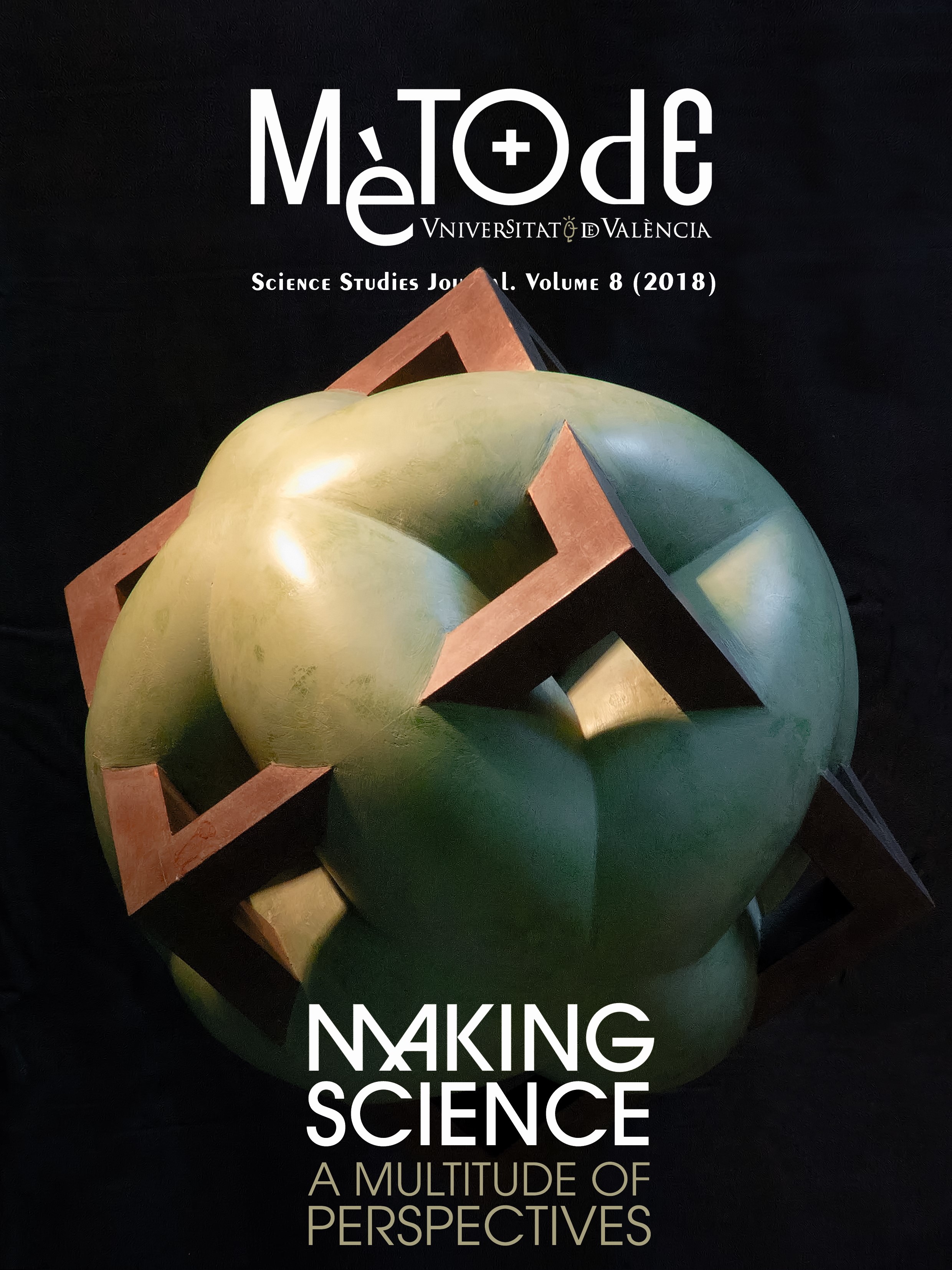Pseudociència i mala ciència en biomedicina: Anàlisi d’evidències, riscos per a la salut i difusió mediàtica
DOI:
https://doi.org/10.7203/metode.8.10019Paraules clau:
pseudociència, mala ciència, biomedicina, medicines complementàries i alternatives, comunicació científica Resum
Resum
La pseudociència (falsa ciència) i la ciència basada en estudis defectuosos i esbiaixats (mala ciència) produeixen coneixement fals o incert, sense proves o amb evidències de baixa qualitat. Ambdues representen un risc per a la salut: les teràpies basades en pseudociència, perquè poden reemplaçar o retardar els tractaments convencionals i la biomedicina de baixa qualitat perquè propicia intervencions mèdiques que poden ser perilloses. En la premsa, les teràpies alternatives tenen menor presència que les investigacions de baixa qualitat, mentre que l’enquadrament sol ser negatiu per a les primeres i positiu per a les segones. Ambdues necessiten estudis més complets i rigorosos per a comprendre millor els seus efectes negatius sobre el pensament crític, l’economia i la presa de decisions que afecten la salut.
 Descàrregues
Descàrregues
 Referències
Referències
Angell, M., & Kassirer, J. P. (1998). Alternative medicine: The risks of untested and unregulated remedies. The New England Journal of Medicine, 339(12), 839–841. doi: 10.1056/NEJM199809173391210
Baker, M. (2016). 1,500 scientists lift the lid on reproducibility. Nature, 533(7604), 452–454. doi: 10.1038/533452a
Bauer, M. (1998). The medicalization of science news: From the “rocket-scalpel” to the “gene-meteorite” complex. Social Science Information, 37(4), 731–751. doi: 10.1177/053901898037004009
BMJ Publishing Group Limited. (2017). What conclusions has Clinical Evidence drawn about what works, what doesn’t based on randomised controlled trial evidence? Retrieved on 4 September 2017 from http://clinicalevidence.bmj.com/x/set/static/cms/efficacy-categorisations.html
Camí, J., Méndez-Vásquez, R. I., & Suñén-Pinyol, E. (2008). Evolución de la productividad científica de España en biomedicina (1981-2006). Redes, 10, 24–29. Retrieved from https://www.medicamentos-innovadores.org/sites/default/files/medinnovadores/Espa%C3%B1ol/Publicaciones/Revista%20Redes/Marzo%202008/REDES_10.pdf
Chalmers, I., & Glasziou, P. (2009). Avoidable waste in the production and reporting of research evidence. The Lancet, 374(9683), 86–89. doi: 10.1016/S0140-6736(09)60329-9
Cortiñas-Rovira, S., Alonso-Marcos, F., Pont-Sorribes, C., & Escribà-Sales, E. (2015). Science journalists’ perceptions and attitudes to pseudoscience in Spain. Public Understanding of Science, 24(4), 450–465. doi: 10.1177/0963662514558991
Djulbegovic, B., & Hozo, I. (2007). When should potentially false research findings be considered acceptable? PLoS Medicine, 4(2), 0211–0217. doi: 10.1371/journal.pmed.0040026
Dumas-Mallet, E., Smith, A., Boraud, T., & Gonon, F. (2017). Poor replication validity of biomedical association studies reported by newspapers. PLoS ONE, 12(2), e0172650. doi: 10.1371/journal.pone.0172650
Escribà-Sales, E., Cortiñas Rovira, S., & Alonso-Marcos, F. (2015). La pseudociencia en los medios de comunicación: Estudio de caso del tratamiento de la homeopatía en la prensa española y británica durante el período 2009-2014. Panace@, 16(42), 177–183.
Goldacre, B. (2009). Bad science. London: Harper Perennial.
Gonon, F., Konsman, J. P., Cohen, D., & Boraud, T. (2012). Why most biomedical findings echoed by newspapers turn out to be false: The case of attention deficit hyperactivity disorder. PLoS ONE, 7(9), e44275. doi: 10.1371/journal.pone.0044275
Goodman, S., & Greenland, S. (2007). Why most published research findings are false: Problems in the analysis. PLoS Medicine, 4(4), e168. doi: 10.1371/journal.pmed.0040168
Guyatt, G. H., Oxman, A. D., Vist, G. E., Kunz, R., Falck-Ytter, Y., Alonso-Coello, P., & Schünemann, H. J. (2008). GRADE: An emerging consensus on rating quality of evidence and strength of recommendations. British Medical Journal, 9(1), 8–11. doi: 10.1136/bmj.39489.470347.AD
Haynes, R. B. (2005). Bmjupdates+, a new free service for evidence-based clinical practice. Evidence-Based Mental Health, 8(3), 62–63. doi: 10.1136/ebmh.8.3.62
Ioannidis, J. P. A. (2005). Why most published research findings are false. PLoS Medicine, 2(8), e124. doi: 10.1371/journal.pmed.0020124
Johnson, S. B., Park, H. S., Gross, C. P., & Yu, J. B. (2018). Use of alternative medicine for cancer and its impact on survival. Journal of the National Cancer Institute, 110(1), 1–4. Pre-published online. doi: 10.1093/jnci/djx145
Lai, W. Y. Y., & Lane, T. (2009). Characteristics of medical research news reported on front pages of newspapers. PLoS ONE, 4(7), e6103. doi: 10.1371/journal.pone.0006103
Mercurio, R., & Eliott, J. A. (2011). Trick or treat? Australian newspaper portrayal of complementary and alternative medicine for the treatment of cancer. Supportive Care in Cancer, 19(1), 67–80. doi: 10.1007/s00520-009-0790-4
Ministry of Health, Social Policy, and Equality. (2011). Análisis de situación de las terapias naturales. Madrid: MSPSI. Retrieved from http://www.mspsi.gob.es/novedades/docs/analisisSituacionTNatu.pdf
Moreno-Castro, C., & Lopera-Pareja, E. H. (2016, 26-28 April). Comparative study of the frequency of use of natural therapies among the Spanish population and their public image on digital media. 14th International Conference on Public Communication of Science and Technology (PCST), Estambul, Turquía. Retrieved from https://pcst.co/archive/paper/2623
Munafò, M. R., Nosek, B. A., Bishop, D. V. M., Button, K. S., Chambers, C. D., Percie du Sert, N., … Ioannidis, J. P. A. (2017). A manifesto for reproducible science. Nature Human Behaviour, 1(1), 21. doi: 10.1038/s41562-016-0021
Schoenfeld, J. D., & Ioannidis, J. P. A. (2013). Is everything we eat associated with cancer? A systematic cookbook review. The American Journal of Clinical Nutrition, 97(1), 127–134. doi: 10.3945/ajcn.112.047142
Sumner, P., Vivian-Griffiths, S., Boivin, J., Williams, A., Bott, L., Adams, R., … Chambers, C. D. (2016). Exaggerations and caveats in press releases and health-related science news. PLoS ONE, 11(12), e0168217. doi: 10.1371/journal.pone.0168217
Sumner, P., Vivian-Griffiths, S., Boivin, J., Williams, A., Venetis, C. A., Davies, A., … Chambers, C. D. (2014). The association between exaggeration in health related science news and academic press releases: Retrospective observational study. British Medical Journal (Clinical Research Edition), 349(dec09_7), g7015. doi: 10.1136/bmj.g7015
Descàrregues
Publicades
Com citar
-
Resum2861
-
PDF 976
Número
Secció
Llicència
![]()
Tots els documents inclosos en OJS són d'accés lliure i propietat dels seus autors.
Els autors que publiquen en aquesta revista estan d'acord amb els següents termes:
- Els autors conserven els drets d'autor i garanteixen a la revista el dret a la primera publicació del treball, llicenciat baix una llicència de Reconeixement-NoComercial-SenseObraDerivada 4.0 Internacional de Creative Commons, que permet a altres compartir el treball amb un reconeixement de l'autoria del treball i citant la publicació inicial en aquesta revista.
- Es permet i s'anima els autors a difondre la versió definitiva dels seus treballs electrònicament a través de pàgines personals i institucionals (repositoris institucionals, pàgines web personals o perfils a xarxes professionals o acadèmiques) una vegada publicat el treball.





